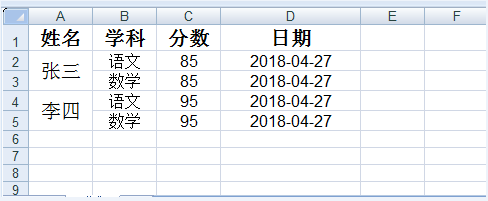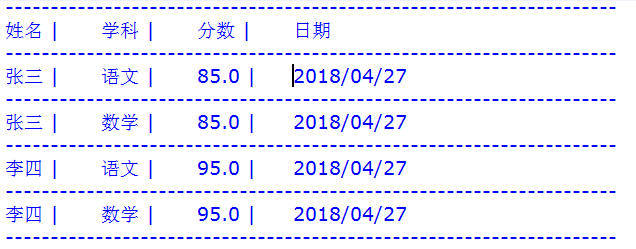Python简单读写Xls格式文档的方法示例
2018-08-17 14:24
1356 查看
本文实例讲述了Python简单读写Xls格式文档的方法。分享给大家供大家参考,具体如下:
1. 模块安装
使用
pip install命令安装,
即:
pip install xlrd
pip install xlwt
如下图:


2. python 代码
import xlrd
import xlwt
import datetime
def set_style(name,height,format,bold=False):
style = xlwt.XFStyle()
if format.strip()!='':
style.num_format_str =format
font = xlwt.Font()
font.name=name
font.bold=bold
font.color_index=4
font.height=height
alignment = xlwt.Alignment()
#HORZ_GENERAL, HORZ_LEFT, HORZ_CENTER, HORZ_RIGHT, HORZ_FILLED, HORZ_JUSTIFIED, HORZ_CENTER_ACROSS_SEL, HORZ_DISTRIBUTED
alignment.horz = xlwt.Alignment.HORZ_CENTER
#VERT_TOP, VERT_CENTER, VERT_BOTTOM, VERT_JUSTIFIED, VERT_DISTRIBUTED
alignment.vert = xlwt.Alignment.VERT_CENTER
style.alignment = alignment
style.font=font
return style
def set_colstyle(sheet,cindex):
col=sheet.col(cindex)
col.width =256*20
#col.height =100
def writeXls(path):
wb = xlwt.Workbook()
sheet = wb.add_sheet('测试',cell_overwrite_ok=True)
set_colstyle(sheet,3)
#标题
heads=['姓名','学科','分数','日期']
for h in range(0,len(heads)):
sheet.write(0,h,heads[h],set_style('Arial',300,'',True))
#数据
sheet.write_merge(1,2,0,0,'张三',set_style('Arial',300,'',False))
sheet.write(1,1,'语文',set_style('Arial',240,'',False))
sheet.write(1,2,85,set_style('Arial',240,'',False))
sheet.write(1,3,datetime.date.today(),set_style('Arial',240,'yyyy/mm/dd',False))
sheet.write(2,1,'数学',set_style('Arial',240,'',False))
sheet.write(2,2,85,set_style('Arial',240,'',False))
sheet.write(2,3,datetime.date.today(),set_style('Arial',240,'yyyy/mm/dd',False))
sheet.write_merge(3,4,0,0,'李四',set_style('Arial',300,'',False))
sheet.write(3,1,'语文',set_style('Arial',240,'',False))
sheet.write(3,2,95,set_style('Arial',240,'',False))
sheet.write(3,3,datetime.date.today(),set_style('Arial',240,'yyyy/mm/dd',False))
sheet.write(4,1,'数学',set_style('Arial',240,'',False))
sheet.write(4,2,95,set_style('Arial',240,'',False))
sheet.write(4,3,datetime.date.today(),set_style('Arial',240,'yyyy/mm/dd',False))
wb.save(path)
def ismerge(sheet,merge,r,c):
#merge=sheet.merged_cells
for m in merge:
if r>=m[0] and r<m[1] and c==m[2]:
r=m[0]
c==m[2]
break
return r,c
def readXls(path):
wb=xlrd.open_workbook(path,formatting_info=True)
#sheetname=wb.sheet_names()[0]
sheet=wb.sheet_by_index(0)
rows=sheet.nrows
cols=sheet.ncols
merge=sheet.merged_cells
#merged_cells返回的这四个参数的含义是:(row,row_range,col,col_range),
#其中[row,row_range)包括row,不包括row_range
print('--------------------------------------------------------------------')
for r in range(0,rows):
listStr = []
for c in range(0,cols):
merg=ismerge(sheet,merge,r,c)
if (sheet.cell(merg[0],merg[1]).ctype==3):
data_value=xlrd.xldate_as_tuple(sheet.cell_value(merg[0],merg[1]),wb.datemode)
#print(datetime.date(*data_value[:3]).strftime('%Y/%m/%d'))
listStr.append(datetime.date(*data_value[:3]).strftime('%Y/%m/%d'))
else:
#print(sheet.cell_value(merg[0],merg[1]))
listStr.append(sheet.cell_value(merg[0],merg[1]))
#print(sheet.cell(merg[0],merg[1]).value)
#print(sheet.cell(r,c).ctype)
print(' |\t'.join(str(s) for s in listStr if s not in [None]))
print('--------------------------------------------------------------------')
if __name__ == '__main__':
#writeXls('H:\测试.xls')
readXls('H:\测试.xls')
3.效果展示


更多关于Python相关内容感兴趣的读者可查看本站专题:《Python操作Excel表格技巧总结》、《Python文件与目录操作技巧汇总》、《Python文本文件操作技巧汇总》、《Python数据结构与算法教程》、《Python函数使用技巧总结》、《Python字符串操作技巧汇总》及《Python入门与进阶经典教程》
希望本文所述对大家Python程序设计有所帮助。
您可能感兴趣的文章:
- Python操作Excel之xlsx文件
- python脚本实现xls(xlsx)转成csv
- Python中XlsxWriter模块简介与用法分析
- python xlsxwriter库生成图表的应用示例
- Python学习_几种存取xls/xlsx文件的方法总结
- windows下安装Python的XlsxWriter模块方法
- python操作excel的方法(xlsxwriter包的使用)
- python操作excel的包(openpyxl、xlsxwriter)
- python操作xlsx文件的包openpyxl实例
- python3读取csv和xlsx文件的实例
- python 将数据保存为excel的xls格式(实例讲解)
相关文章推荐
- Python实现按特定格式对文件进行读写的方法示例
- Apache POI读写Excel文档入门(支持XLS和XLSX格式)
- POI使用:用poi接口不区分xls/xlsx格式解析Excel文档(41种日期格式解析方法,5种公式结果类型解析方法,3种常用数值类型精度控制办法)
- python中json格式数据输出的简单实现方法
- 解决 Python ruamel.yaml 读写 yaml 文档 format 格式不一致问题
- POI使用:用poi接口不区分xls/xlsx格式解析Excel文档(41种日期格式解析方法,5种公式结果类型解析方法,3种常用数值类型精度控制办法)
- 简单介绍使用Python解析并修改XML文档的方法
- Python简单删除列表中相同元素的方法示例
- Android编程简单解析JSON格式数据的方法示例
- C#编程简单实现生成PDF文档的方法示例
- Python基于Matplotlib库简单绘制折线图的方法示例
- QT XML文档的解析 QXmlStreamReader, DOM,SAX 三种解析方法 简单示例
- Python简单定义与使用字典dict的方法示例
- java简单解析xls文件的方法示例【读取和写入】
- Apache POI:Java程序读写Microsoft Office格式文档——简单完整实例讲解
- python中json格式数据输出的简单实现方法
- Python3读写INI配置文件简单方法
- python中使用xlrd、xlwt读写excel(xls格式)
- python中解析json格式文件的方法示例
- XML文档简单读写方法
